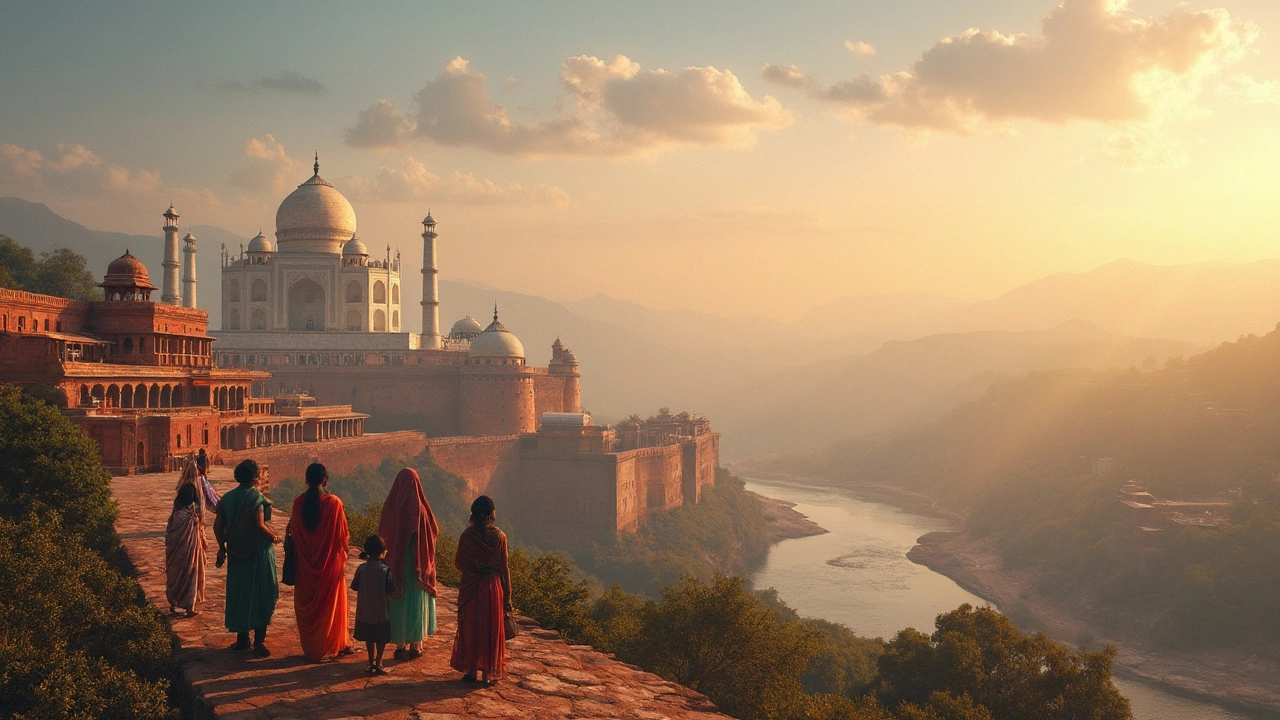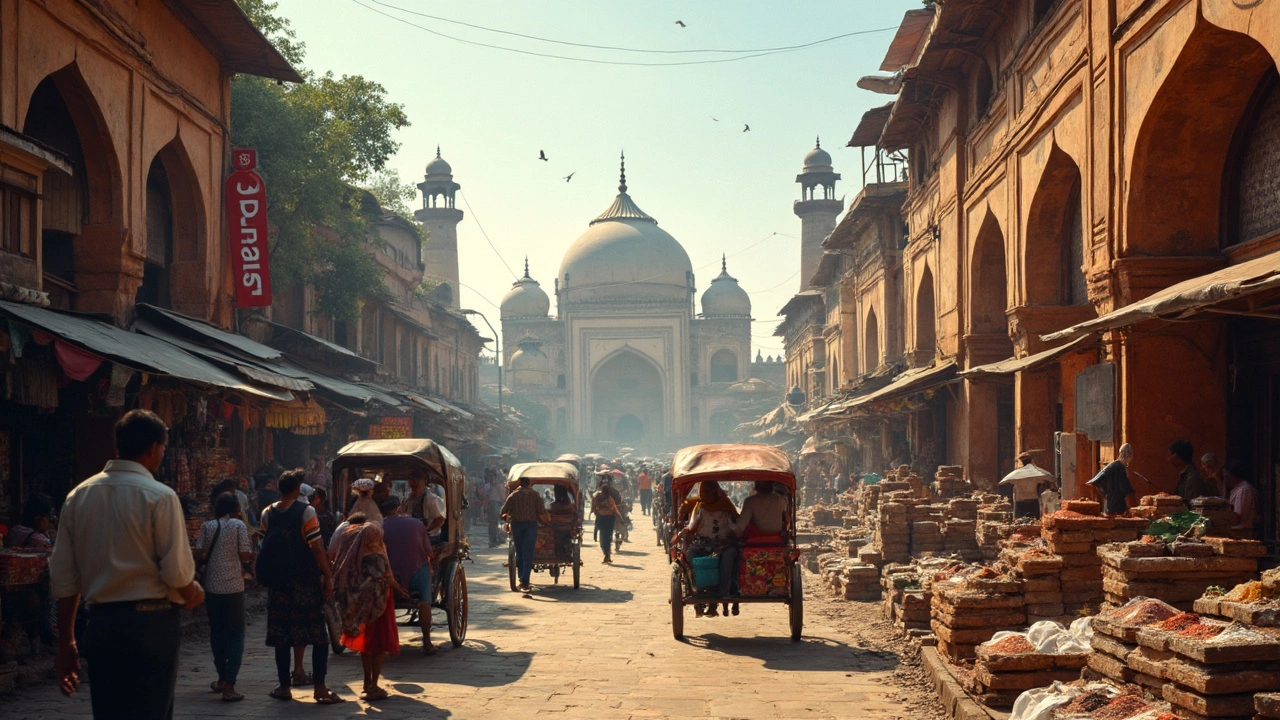Best Heritage Sites in India: Discover the Crown Jewel
 Jun, 3 2025
Jun, 3 2025
Think about a country where ancient forts and giant temples seem almost normal—welcome to India. With 42 UNESCO World Heritage Sites and a list that only gets longer, figuring out which one’s the best can send anybody down a rabbit hole.
If you talk to locals or travelers, the answers swing from the picture-perfect Taj Mahal to the walled wonders of Rajasthan, and then some people throw in the wild stuff like the living root bridges in Meghalaya. The real challenge? All these places offer a different kind of magic—some blow your mind with massive scale, others feel deeply personal because of the stories behind them.
So, how do you pick the champion among all this history and wow-factor? In this guide, you'll get the scoop on what sets these sites apart, secrets that even some travel bloggers miss, and real tips to make your own visit less about crowds and more about goosebumps.
- Why India Has So Many Heritage Sites
- What Makes the Taj Mahal Stand Out
- Beyond the Obvious: Other Jaw-Dropping Heritage Spots
- Tips for Visiting and Making the Most of Your Trip
Why India Has So Many Heritage Sites
If you’ve ever wondered why India seems to have old, jaw-dropping stuff everywhere you turn, there’s a solid reason for it. India is basically a living museum. For over 5,000 years, it’s been home to kings, empires, invaders, monks, merchants, and just about any type of builder and dreamer you can imagine. That kind of non-stop action keeps leaving behind forts, temples, palaces, and even ancient cities tucked under everyday places.
One glance at the map and it’s obvious—India wasn’t ruled by just one group. You’ve got the Mauryans, Guptas, Cholas, Mughals, British, and so many more. Each dynasty left behind its own style. Temples in the south? All about stone carvings. Northern forts? Tall walls and giant gates to show off serious muscle. Mughal gardens and palaces? Fancy, with an eye for symmetry.
Another reason is the mash-up of cultures and religions. Where else will you see a 5,000-year-old Hindu temple, a centuries-old mosque, and a European-built church in one city? This variety pops up because India’s always blended ideas and people from inside and outside the country—thanks, trade routes and conquests.
India now has 42 UNESCO World Heritage Sites, and it’s among the top ten countries with the most entries on the list. Check this out:
| Country | Number of UNESCO Sites (2025) |
|---|---|
| Italy | 59 |
| China | 57 |
| Germany | 52 |
| India | 42 |
The biggest clusters are in states like Rajasthan, Maharashtra, Uttar Pradesh, Karnataka, and Tamil Nadu. Most of the new sites added in the last decade are also outside the main cities, so you have to travel off the typical path to find some of the best stories.
Why does UNESCO keep picking Indian landmarks? Here’s why:
- They’re super old (some go back to 2500 BC, like the rock-cut caves at Ellora).
- They mix cultural, historic, artistic, and natural value.
- They matter globally—not just to locals.
All this means anyone hunting for the heritage sites india experience is spoiled for choice. The challenge isn’t finding a site—it’s deciding which epic one to start with.
What Makes the Taj Mahal Stand Out
Let’s be honest, the Taj Mahal almost always comes up first when people talk about the best heritage sites in India. And there’s a good reason for that: it’s not just another old building. It’s the heritage sites india superstar that pulls in almost 7 to 8 million visitors every year. Even if you’re not a history geek, the story behind the Taj makes you pause. Built by Mughal emperor Shah Jahan for his wife Mumtaz Mahal around the 17th century, this place is literally a monument to love. But the hype isn’t just about romance—the design and engineering are wild too.
Here’s how it stands out from the crowd:
- Iconic Design: The whole thing is perfectly symmetrical. If you split it down the middle, each side is a mirror image. The white marble and the way it grabs changing colors during sunrise and sunset? You don’t get that anywhere else.
- Craftsmanship: Over 20,000 workers and specialists were involved, including stonecutters from Afghanistan and calligraphers from Persia. They made sure every bit, from the giant dome to tiny inlay work, was on point.
- Surprising Facts: The minarets are built slightly outward. Not a mistake—it’s so if there’s an earthquake, they’ll fall away from the main structure instead of crashing into it.
- Status: It became a UNESCO World Heritage Site in 1983 and made it into the New7Wonders of the World.
Check out these quick stats about the Taj Mahal that will blow your mind:
| Fact | Value |
|---|---|
| Year construction started | 1632 |
| Year completed | 1653 |
| Height of main dome | 73 meters (240 feet) |
| Total cost back in the day | About 32 million rupees (that’s billions today) |
| Annual visitors | 7–8 million |
The atmosphere at the Taj is its own thing. I still remember the first time Maya and I went there early in the morning. It was eerily quiet, almost like the marble absorbed the noise. Zero chaos, just the sound of our steps—and laughs as we realized we’d both worn socks with cartoons on them. It’s wild to see just how many people fly in from all corners, just to tick this spot off their bucket list.
The Taj Mahal is "the greatest architectural achievement in the whole range of Indo-Islamic architecture" — Archaeological Survey of India
Pro tips? Morning visits are the best to avoid crowds. Don’t skip the actual tomb chamber—even if it feels touristy, the real relics and marble details are way cooler in person than in any photo.

Beyond the Obvious: Other Jaw-Dropping Heritage Spots
India’s not just about the Taj Mahal. If you want your trip to actually stand out, you’ve got to check out the often-missed places shaking up everyone’s list. Some of the heritage sites india shows off don’t make it to the main postcards, but once you’re there, you’ll wonder why everyone doesn’t talk about them more.
Let’s look at a few that genuinely stand out from the crowd:
- Hampi – Scattered boulders and ancient temple ruins make this Karnataka town look like the set of an Indiana Jones movie. In the 1500s, Hampi was the capital of the Vijayanagara Empire and one of the world’s biggest cities. Now, it’s a place where you can wander giant stone bazaars and climb rocks for sunrise views.
- Khajuraho – Want temples with stories? The carvings here are famous for being bold, detailed, and honestly, a little cheeky. You’ll find around 20 temples standing today, out of 85 originally built between AD 950 and 1050.
- Fatehpur Sikri – This city near Agra was a Mughal palace complex built by Emperor Akbar. It only lasted for about 14 years due to water shortages, but walking through its red sandstone courtyards, you can almost hear the old royal debates. Pro tip: Go early in the morning before the crowds.
- Kaziranga National Park – It’s not castles or temples, but this UNESCO spot in Assam is home to more than two-thirds of the world’s Indian one-horned rhinos. Safaris here work best from November to April if you want a good chance of spotting rhinos.
- Ajanta and Ellora Caves – These rock-cut caves in Maharashtra cover Buddhist, Hindu, and Jain art all in one spot. The Ajanta caves date back to the 2nd century BCE, and Ellora’s big Kailasa Temple? It’s literally carved out of a single rock. Getting around can take a day, so start early and pack snacks.
Here’s a quick table to compare details, so you can pick which one fits your vibe and timeline:
| Site Name | Location | Known For | Best Time to Visit |
|---|---|---|---|
| Hampi | Karnataka | Ruined city, temple clusters | Oct - Feb |
| Khajuraho | Madhya Pradesh | Sculpted temples | Nov - Mar |
| Fatehpur Sikri | Uttar Pradesh | Palaces, city walls | Nov - Mar |
| Kaziranga National Park | Assam | Wildlife, rhinos | Nov - Apr |
| Ajanta & Ellora Caves | Maharashtra | Cave temples, ancient art | Nov - Mar |
These places don’t just tick boxes on a UNESCO list—they stick in your head. If you want bragging rights for seeing something different in India, aim for at least one of these before the big crowds figure it out.
Tips for Visiting and Making the Most of Your Trip
If you’re planning to hit India’s heritage sites india circuit, don’t just book a ticket and wing it. These spots pull in millions every year, so a little prep goes a long way (and can also save you serious headaches).
- Beat the crowds: Aim for early mornings or late afternoons. The Taj Mahal’s gates open at sunrise and that’s hands-down the best time, both for softer light and emptier photos.
- Buy tickets online when possible: Big sites like Taj Mahal and Qutub Minar sell digital tickets through their official ASI or UNESCO pages. No need to sweat in a giant line.
- Dress with some respect: These places aren’t just photo ops—they mean a lot to people. Cover shoulders and knees, and at temples, ditch shoes at the entrance. Saves you glares and awkward security checks.
- Guides vs. DIY: Sometimes you really do get more with an official guide. At Ajanta and Ellora Caves, for example, a guide can point out details you’d totally miss (like stories hidden in the carvings). Check for the ASI badge, not the touts.
- Hydration and snacks: A bunch of heritage sites sit in sun-baked regions. Pack water and a quick snack. Outside food is usually a no-go inside, but you can always step out for a break.
- Photography rules change place to place: At Elephanta Caves or inside some temples, photography is a flat no. Check signs or ask your guide before your phone comes out.
- Double-check open and closed days: For example, the Taj Mahal stays shut every Friday. Not fun if your whole plan circles around a Friday visit.
Want to see how packed or popular each spot is? Here’s what the annual number of visitors looked like for a few top Indian sites in the last normal year (2019):
| Heritage Site | Approx. Annual Visitors (2019) |
|---|---|
| Taj Mahal | ~6.9 million |
| Qutub Minar | ~3.8 million |
| Red Fort | ~3.6 million |
| Khajuraho Group of Monuments | ~450,000 |
| Ajanta Caves | ~350,000 |
A few small things make a big difference: carry power banks (electric outlets are near impossible to find), skip weekends when you can, and if you’re traveling as a woman or with family like I do with Maya, don’t stress about safety at UNESCO sites—they’re always patrolled and busy. Local guides usually know a place nearby for good chai or an authentic lunch, too. Make talking to them part of the trip.